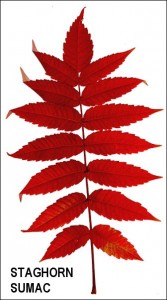The sumac leaves have turned scarlet and the end of the season is finally near. It’s time to clear away this summer’s garden and get tender plants into the house or the greenhouse before the first frost hits.

Hygiene is important outdoors as well as indoors. Many insects, disease-causing bacteria and fungal spores can overwinter in leaf litter or in soil, so wherever I’ve had a disease problem I’m careful about cleanup. This summer, for example, I stubbornly planted a few pots of impatiens, although I was fully aware of a disease called impatiens downy mildew that has been running rampant in the horticulture industry. Sure enough, my impatiens withered and died. Knowing that the fungus spores can persist for years in garden soil, I carefully disposed of the plants and potting soil and washed the pots in a solution of 1 part bleach to 9 parts water before I put them away.
It’s important to get rid of all diseased plant parts outside the garden. If you add them to your compost pile, you may just be spreading disease next year, because most home compost piles don’t get hot enough to kill disease-causing microbes and insect eggs; in fact, the pile may just give them a safe haven through the winter. Instead, I package all plants and potting mix that had any contact with disease in big brown paper bags and set them out to be hauled away as landscape waste. That waste goes to huge, industrial-scale commercial composting operations, where the piles will get hot enough to kill disease pathogens.
What most people think of as garden cleanup—cutting down dried stalks and raking away fallen leaves—is largely a matter of taste and personal tidiness; plants don’t need it. I leave many flower stalks standing for winter interest and seeds for the birds, and I cherish leaves as valuable mulch. I shred leaves on the lawn so they don’t smother the grass, but they don’t offend my aesthetic sense, so the perennials get their protection through the winter.
 The 10 percent bleach-and-water solution also is useful for cleaning greenhouse glass, benches and floors. In the closed system of a greenhouse, any disease or insect that gets a foothold can become a big problem, so even if you’re always careful, a yearly disinfecting swab is good insurance. Of course, remove all plants before you start swabbing.
The 10 percent bleach-and-water solution also is useful for cleaning greenhouse glass, benches and floors. In the closed system of a greenhouse, any disease or insect that gets a foothold can become a big problem, so even if you’re always careful, a yearly disinfecting swab is good insurance. Of course, remove all plants before you start swabbing.
My tropical houseplants run a gauntlet before they get inside my house in fall. My big concern is insects: Outdoors, they do little harm because predators keep them in check. Indoors, they can run rampant.
First my houseplants get a strong spray from the hose to blast off aphids and other insects and eggs. Then they get a careful examination for any signs of infestation, which I usually treat with an insecticidal soap spray. Then they spend several days on the porch, under cover and protected from early frosts. That gives me a chance to spot pests before they come inside.
Giving the plants good conditions indoors will forestall most problems. To deter spider mites, which thrive in dry indoor air, I provide humidity from a humidifier or by setting the pots on gravel in humidity trays. Making sure the plants have good potting mix that drains well and that excess water can run away freely will prevent fungus gnats, which thrive in sodden soil. Reliable watering, reasonable light conditions (or a greenhouse) and moderate fertilizing starting in late winter will keep the plants healthy enough to fight off most problems.


